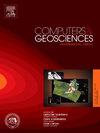Exploiting global information and local edge detail for full waveform inversion
IF 4.4
2区 地球科学
Q1 COMPUTER SCIENCE, INTERDISCIPLINARY APPLICATIONS
引用次数: 0
Abstract
Data-driven deep learning full waveform direct inversion (DL-FWI) has emerged as an advanced technique for predicting subsurface structures. Popular approaches frequently encounter blurry edge pixels and inaccurate velocity values. Here, we propose an algorithm called TU-Net that captures both global information and local edge detail to address these issues. With respect to the network design, we incorporate a texture warping module (TWM) into the skip connections of the U-Net backbone. Due to the multi-scale feature extraction ability of TWM, our network is able to learn details in complex regions. With respect to the loss function design, we introduce the mixed pixel and edge (MPE) loss, which is a combination of the mean absolute error, the mean square error, and the edge-based losses. The newly proposed loss function balances the model’s focus on global pixel features with the local edge characterization, driving the network to produce high-quality edges. We apply the proposed approach on publicly available OpenFWI, SEG salt and Marmousi II datasets. Quantitative results demonstrate that TU-Net achieves better performance in terms of MSE, MAE, LPIPS, PSNR, UIQ, and SSIM than four state-of-the-art deep networks. The source code is available at github.com/fansmale/TU-Net.
利用全局信息和局部边缘细节进行全波形反演
数据驱动的深度学习全波形直接反演(DL-FWI)已经成为预测地下结构的先进技术。常用的方法经常遇到模糊的边缘像素和不准确的速度值。在这里,我们提出了一种称为TU-Net的算法,它可以捕获全局信息和局部边缘细节来解决这些问题。在网络设计方面,我们将纹理翘曲模块(TWM)集成到U-Net骨干网的跳接中。由于TWM的多尺度特征提取能力,我们的网络能够学习到复杂区域的细节。在损失函数设计方面,我们引入了混合像素和边缘(MPE)损失,它是平均绝对误差、均方误差和基于边缘的损失的组合。新提出的损失函数平衡了模型对全局像素特征和局部边缘特征的关注,推动网络产生高质量的边缘。我们将提出的方法应用于公开可用的OpenFWI、SEG salt和Marmousi II数据集。定量结果表明,TU-Net在MSE、MAE、LPIPS、PSNR、UIQ和SSIM方面的性能优于四种最先进的深度网络。源代码可从github.com/fansmale/TU-Net获得。
本文章由计算机程序翻译,如有差异,请以英文原文为准。
求助全文
约1分钟内获得全文
求助全文
来源期刊

Computers & Geosciences
地学-地球科学综合
CiteScore
9.30
自引率
6.80%
发文量
164
审稿时长
3.4 months
期刊介绍:
Computers & Geosciences publishes high impact, original research at the interface between Computer Sciences and Geosciences. Publications should apply modern computer science paradigms, whether computational or informatics-based, to address problems in the geosciences.
 求助内容:
求助内容: 应助结果提醒方式:
应助结果提醒方式:


